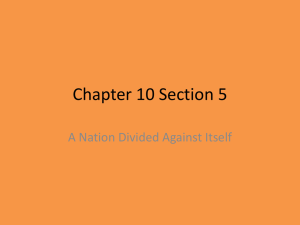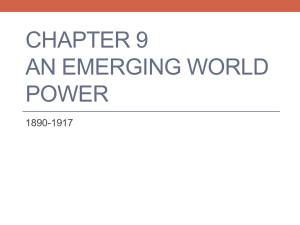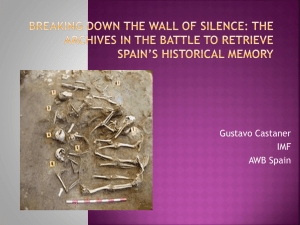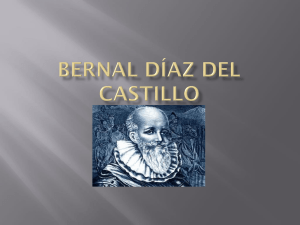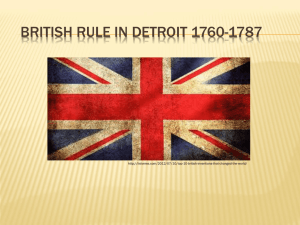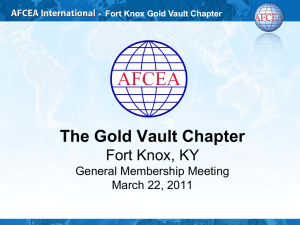St. Augustine*s Castillo de San Marcos
advertisement
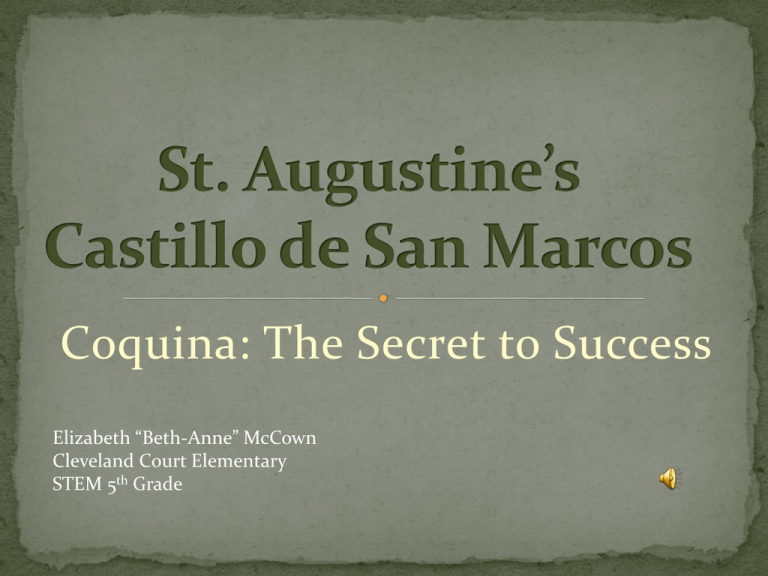
Coquina: The Secret to Success Elizabeth “Beth-Anne” McCown Cleveland Court Elementary STEM 5th Grade 1. She’s a Grand Ole Town— (Brief history of St. Augustine and the Castillo) 2. Co-Whatchamakalit?--(What is coquina?) 3. Layers of Security— (Building the Castillo) 4. In Coquina We Trust-(Castillo Attacks) 5. Owe It All To Old Coquina-(New Rulers) 6. Mirror, Mirror, Who’s the Fairest— (What does the Castillo look like?) 7. The “Nip & Tuck” of It(Archaeology at the Castillo) 8. Chalk It Up to Coquina--(Assessments) Ambush, Archaeology, Coarse, Compacted, Coquina, Edifice, Erode, Excavate, Foundation, Layer Mainland, Mason, Mine, Midden, Moat, Mortar, National Park, Outcropping, Oxen, Pavers, Quarry, Quarters, Raft, Siege, Slab, State Park, Tabby Option 1: Regular Handout (Your Copy) Option 2: Pair/Share Word Sort Option 3: Kagan’s Quiz, Quiz, Trade St. Augustine is the United States’ oldest city. It survived for many years due to a huge coquina fort, called the Castillo de San Marcos. This fortress protected the city from pirates and British attacks. Later, this fort was used in the Seminole Wars and in the Civil War. Florida’s history would have been very different without this edifice. •St. Augustine is established in 1565 by Pedro Menendez de Aviles. •Sir Francis Drake attacks St. Augustine in 1586 and burns the town to the ground. •English pirates attack in 1668. Sack the city, but fail to take the current wooden fort. •In 1669, Queen Regent Mariana of Spain ORDERS the construction of a Fort at St. Augustine. •The Castillo de San Marcos is built from coquina, a coastal shell rock. •It takes from 1672-1695 to build. •Its designer is engineer Ignacio Daza. •It features a height of 26 feet, a beam-supported gundeck, and a courtyard of 155 feet. Coquina is a shell-like stone that occurs naturally along the east coast of Florida. You can see outcroppings of this stone along its beaches. Sometimes you are even able to climb on coquina stones that stick right up out of the sand! Coquina is a fairly soft stone. The Spanish workers had to carefully check each stone before they cut it. Only the hardest stone could be used to build the Fort. While it’s wet, even the hardest coquina can be cut with a saw or an axe. The coquina walls you see at the Castillo today are dark and gray, but fresh coquina is yellow. It changes color as it dries. (See image above.) Kagan Numbered Heads/Teach-Okay: Why wouldn’t you want to build your fort with only fresh coquina? A quarry is a place where people go to mine/dig up minerals or stone. The Spanish mined coquina stone from 14 actual quarries. You can visit the Old Spanish Quarry on Anastasia Island. That’s where the Spanish mined coquina stone for the Castillo de San Marcos. There are still original spots where Face Partner/Teach-Okay: If you visit the quarry, what would you likely see coquina blocks were cut long there besides the coquina excavations? ago. (Hint: People did all the work there. Do they “leave” clues behind?) Both the Timucua Natives and the Spanish settlers/soldiers dug through the sand until they reached a layer of solid coquina stone. Chunks of coquina were mined in various sizes. The larger pieces (four feet long and two feet thick) took six men just to budge them. Skilled stoneworkers (masons) shaped the rough coquina blocks. Next, they loaded the coquina blocks onto ox-drawn carts. The Spanish dug several wells along the way to give the oxen places to rest and drink. When the oxen reached the coast, workers loaded the stone onto sturdy rafts, which floated blocks to the mainland. Once the soft, yellow coquina stone had been unloaded, it had to sit and dry out for a period of up to THREE years. (Courtesy of Historic Print & Map Co, St. Augustine) While waiting on the coquina to harden, the settlers/soldiers worked on making mortar (to use as glue in the Fort’s coquina walls). They made this mortar by burning oyster shells and then adding water. The Spanish dug oyster shells out of old Timucua Indian trash piles (called middens). Many of the native middens around St. Augustine have disappeared because the Spanish used this shell resource. In a single year, the Spanish could make enough lime mortar to fill the backs of 145 pickup trucks! They also built up a huge pile of drying coquina blocks.. (Courtesy of Historic Print & Map Co, St. Augustine) Shoulder Partner/Teach-Okay: Why would this practice of using the “middens” hinder an archaeologist’s knowledge of past peoples? The Spanish workers suffered while building the fort: •Ran out of money. •Ran out of food. •Supply ships late or never came •Pirate attacks •Battles with the British The year of 1677 is the pinnacle of these delays. The government had run out of money to pay workers and buy supplies. For two whole years, no work was done on the Fort. Then, a couple of years later, the government ran out of food. Construction had to stop again. The government got so desperate that they bought food from a passing Dutch ship, even though it was against the law. Four years later, in 1687, the government ran out of money again. In 1689, they ran out of food again. Face Partner/Teach-Okay: Discuss a possible solution to the on-going money/food issues. It wasn’t until 12 years into the build, the Spanish actually installed the first bathrooms or latrines. They were pretty ingenious… Twice a day, when the tide came in, all the waste was washed away. These latrines (Florida’s first flush toilets) really improved the worker’s lives – unless they happened to be swimming on the beach….GROSS! They also built rooms to store food, quarters for soldiers to sleep in, and a prison. During this time, they also dug the moat – the wide ditch surrounding the Fort. Attacking British soldiers would now have to climb down into that moat to reach the Fort’s walls. They would be easy to shoot while crossing this dry, open ditch. •In 1763, the new British rulers took control of the Castillo and named it Fort St. Mark. •controlled Florida for 20 years due to the rebelling Northern colonies. (American Revolution, 1776). Florida given back to Spain. In 1821, Spain agreed to give up their rights to Florida to the United States. This time the old coquina fort was named Fort Marion. • Florida became a state in 1845. Important Tidbits: •In 1837, the government captured the Seminole Chief, Osceola. They imprisoned him at Ft. Marion for a short time. • In 1862, during the Civil War, Union soldiers captured Ft. Marion from Confederate forces without firing a shot. • In 1875, the fort was used to imprison Native Americans. The native people were from the Great Plains region out west. These Cheyenne, Arapaho, Comanche, and Kiona men had refused to settle on reservations. The Fort’s roof was covered with the tents of these captured native people. • In 1933, Ft. Marion stopped being a military installation and became a National Park. • In 1942, the U.S. government changed the fort’s name back to Castillo de San Marcos. They did this to honor the Spanish workers who had spent so many years building it. •Once the fort was an established National Park, the reservationists had differences of opinion regarding the moat. The picture on the left shows a dry moat (ditch) that goes around the fort-- just like it was back in the Spanish days. So why do we sometimes see pictures of the Castillo that show a moat filled with water? (Photo to the right.) From 1938 to 1996, the moat was filled with water. Why? The Fort’s caretakers believed that the Spanish had also filled the moat with water, so they allowed seawater to flow in. They hoped this would make the Fort more realistic. (Today, we know the moat was only flooded when the Fort was under attack.) Once the moat was full of seawater, the Fort’s coquina walls started soaking up all that moisture. Old cracks in the coquina stone got longer and wider! The National Park Service drained the moat and repaired the cracks. Its roof – also called the gun deck – had plenty of cracks and leaks as well. Why? Long ago, the Spanish mounted heavy cannons on the Fort’s roof. This weight put a lot of stress on the roof surface, creating cracks. In 1993, the National Park Service decided to look for a solution. First, they researched other solutions that had been tried in the past. Spanish records showed that the gun deck had already started to leak in 1707. From 1890 to 1993, the gun deck had been layered multiple times with concrete and asphalt. It was still cracking from all the stress of the building’s usage and age. The National Park Service decided they needed to excavate down to where the Castillo’s original materials began. After carefully excavating small areas, archaeologists decided to remove all of the concrete layers and any original materials that were no longer strong enough to support the gun deck. Before archaeologists could begin repairs, they had to carefully excavate (dig) down to the original tabby roof made by the Spanish. Their notes described what each layer was made of (for example: concrete, coquina sand, or tabby). They also noted the Munsell Color of each layer. What is a “Munsell Color”? This chart allows scientists to be clear about exactly what color soil they’re observing. These are some of the different colors discovered during the Castillo’s gun deck excavation. SC.4.E.6.2 Benchmark: Identify the physical properties of common earth-forming minerals, including hardness, color, luster, cleavage, and streak color, and recognize the role of minerals in the formation of rocks. SC.4.E.6.3 Benchmark: Recognize that humans need resources found on Earth and that these are either renewable or nonrenewable. SC.4.E.6.4 Benchmark: Describe the basic differences between physical weathering and erosion 1. Weitzel, Kelley. 25 September 2012. http://www.flpublicarchaeology.org. “Castillo De San Marcos”. Florida State Parks. 25 September 2012 2. Weitzel, Kelley. 26 September 2012. http://www.KelleyWeitzel.com

